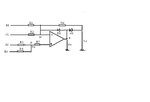anhnha
Full Member level 6
Hi everyone,
Below is is part of solution of my problem, but there are some things make me confuse.
The solution is:
Eo=Up= E2. R4/(R3+R4) + E3. R3/(R3+R4)
If U1< Eo => Un< Up => Ud= Up - Un > 0 => Ua> 0
then D1 is conducted and D2 is not conducted.
If U1> Eo => Un> Up => Ud= Up - Un < 0 => Ua< 0
then D1 is not conducted and D2 is conducted.
What make me confuse is that
I think in order to know a diode is conducted or not we have to know the bias of diode or the voltage is appy to diode, we have to know both the voltage sides of diode.
In the solution why we can conclude when U1< Eo then Un < Up (Why Un is not equal to Up).
Why we can conclude when Ua <0 then D1 is not conducted and D2 is conducted.
Thanks a lot.
Below is is part of solution of my problem, but there are some things make me confuse.
The solution is:
Eo=Up= E2. R4/(R3+R4) + E3. R3/(R3+R4)
If U1< Eo => Un< Up => Ud= Up - Un > 0 => Ua> 0
then D1 is conducted and D2 is not conducted.
If U1> Eo => Un> Up => Ud= Up - Un < 0 => Ua< 0
then D1 is not conducted and D2 is conducted.
What make me confuse is that
I think in order to know a diode is conducted or not we have to know the bias of diode or the voltage is appy to diode, we have to know both the voltage sides of diode.
In the solution why we can conclude when U1< Eo then Un < Up (Why Un is not equal to Up).
Why we can conclude when Ua <0 then D1 is not conducted and D2 is conducted.
Thanks a lot.
